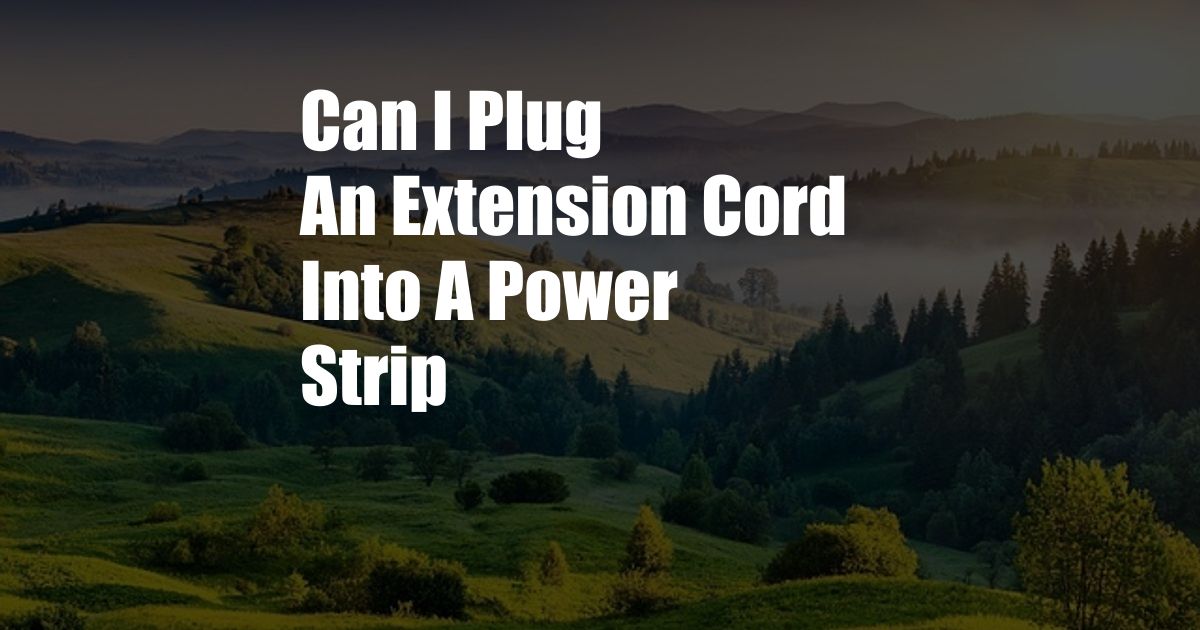
Can I Plug an Extension Cord Into a Power Strip?
In a world where our daily lives are increasingly intertwined with technology, the need for accessible power outlets has become paramount. We often find ourselves in situations where the limited number of available sockets leaves us scrambling for solutions. Extension cords and power strips offer a convenient way to extend our reach, but can we safely plug an extension cord into a power strip? Delve into the details of this common practice to ensure safe and efficient use of electricity.
Is It Safe to Plug an Extension Cord Into a Power Strip?
Power Ratings and Overload Risks
The answer to this question hinges on the power ratings involved. Power strips typically have a maximum wattage capacity, which refers to the total amount of power they can handle safely. Similarly, extension cords also have a wattage rating that indicates the maximum load they can carry. Plugging an extension cord into a power strip effectively adds the power draw of the devices connected to the extension cord to the load on the power strip.
If the combined wattage of the devices plugged into the extension cord exceeds the power strip’s capacity, it can lead to overloading. Overloading can cause the power strip to overheat, potentially triggering a fire hazard or damaging the connected devices. Therefore, it is crucial to consider the power ratings of both the power strip and the extension cord to ensure they can safely handle the electrical load.
Safety Guidelines for Plugging Extension Cords into Power Strips
To ensure safe and effective use of extension cords and power strips, adhere to these guidelines:
- Check Power Ratings: Before connecting an extension cord to a power strip, verify that the combined wattage of the devices plugged into the extension cord does not exceed the power strip’s maximum capacity.
- Avoid Overloading: Never overload a power strip or extension cord by exceeding their respective wattage ratings. Overloading can lead to overheating and potential hazards.
- Use Proper Gauge Extension Cords: Extension cords come in different gauges, which indicate the thickness of the wire. Thicker gauge cords (lower gauge number) can handle higher currents. Choose an extension cord with an appropriate gauge for the intended load.
- Inspect Regularly: Periodically inspect extension cords and power strips for any signs of damage, such as frayed wires or loose connections. Damaged cords or strips pose a safety hazard and should be replaced immediately.
Tips for Efficient and Safe Power Distribution
In addition to the safety guidelines, follow these tips for efficient and safe power distribution:
- Use Surge Protectors: Surge protectors provide an extra layer of protection against voltage spikes, which can damage sensitive electronic devices. Consider using power strips with built-in surge protection.
- Avoid Daisy Chaining: Avoid connecting multiple extension cords together, known as “daisy chaining.” This practice can increase the risk of overloading and potential hazards.
- Unplug When Not in Use: When not in use, unplug extension cords and power strips to conserve energy and reduce the risk of electrical accidents.
FAQs on Plugging Extension Cords into Power Strips
Q: What happens if I plug an extension cord into a power strip that is already at its maximum capacity?
Overloading a power strip can cause it to overheat and potentially start a fire. Additionally, it can damage the connected devices and void their warranties.
Q: Can I use any extension cord with any power strip?
No. Extension cords and power strips have different power ratings. It is important to match the power rating of the extension cord to the power rating of the power strip to avoid overloading.
Q: How often should I inspect extension cords and power strips?
Regularly inspect extension cords and power strips for any signs of damage, such as frayed wires or loose connections. Damaged cords or strips pose a safety hazard and should be replaced immediately.
Conclusion
Plugging an extension cord into a power strip can be a safe and convenient way to extend your reach to power outlets. However, it is crucial to adhere to the safety guidelines outlined above to prevent overloading, overheating, and potential hazards. By considering power ratings, using proper gauge extension cords, and following the tips provided, you can ensure safe and effective power distribution in your home or office.
Are you interested in learning more about electrical safety and efficient power distribution? Explore our blog for additional insights and tips to enhance your knowledge and ensure a safe electrical environment.